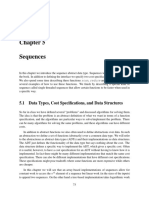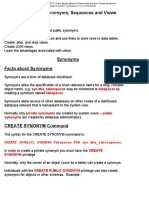0 ratings0% found this document useful (0 votes)
43 viewsChapter - 5: Let's Make Coding Fun!
Sequences are used to generate unique numeric values in databases. A sequence is an Oracle object that can generate values in order on demand, making it useful for automatically populating primary keys. Sequences are independent objects that can be used with any table requiring unique IDs. The CREATE SEQUENCE syntax is used to define sequences by specifying options like the increment, starting value, minimum and maximum values, and whether it cycles or caches.
Uploaded by
Anchugam KeerthiCopyright
© © All Rights Reserved
We take content rights seriously. If you suspect this is your content, claim it here.
Available Formats
Download as PDF, TXT or read online on Scribd
0 ratings0% found this document useful (0 votes)
43 viewsChapter - 5: Let's Make Coding Fun!
Sequences are used to generate unique numeric values in databases. A sequence is an Oracle object that can generate values in order on demand, making it useful for automatically populating primary keys. Sequences are independent objects that can be used with any table requiring unique IDs. The CREATE SEQUENCE syntax is used to define sequences by specifying options like the increment, starting value, minimum and maximum values, and whether it cycles or caches.
Uploaded by
Anchugam KeerthiCopyright
© © All Rights Reserved
We take content rights seriously. If you suspect this is your content, claim it here.
Available Formats
Download as PDF, TXT or read online on Scribd
You are on page 1/ 3
CHAPTER -5
SEquEnCES
Let’s make coding fun!
SEQUENCES
A sequence is a set of integers 1, 2, 3, ... that are generated in order
on demand. Sequences are frequently used in databases because
many applications require each row in a table to contain a unique
value and sequences provide an easy way to generate them.
• Sequence is an Oracle Object that can generate numeric
values
• Sequence is an independent object and can be used with any
table that requires its output
SYNTAX
CREATE SEQUENCE <seq_name>
[INCREMENT BY <value>
START WITH<value>
MAXVALUE<val>/NOMAXVALUE
MINVALUE/NOMINVALUE
CYCLE/NOCYCLE
CACHE/NOCACHE
ORDER/NOORDER]’
EXAMPLE
CREATE SEQUENCE SEQ1
[INCREMENT BY 1
START WITH 1
MAXVALUE 9999999999
MINVALUE 1
CYCLE
ORDER];
COnCLuSIOn
In this chapter, we have covered all about Sequences and its
advantages in maintaining data in tables.
You might also like
- Database Programming With SQL 16-1: Working With Sequences Practice ActivitiesNo ratings yetDatabase Programming With SQL 16-1: Working With Sequences Practice Activities3 pages
- Guide To Using SQL: Sequence Number Generator: A Feature of Oracle RDBNo ratings yetGuide To Using SQL: Sequence Number Generator: A Feature of Oracle RDB17 pages
- Module 15 - Synonyms, Sequences and ViewsNo ratings yetModule 15 - Synonyms, Sequences and Views30 pages
- Unit 4 - DBMS POD Board Question AnswerNo ratings yetUnit 4 - DBMS POD Board Question Answer23 pages
- Sequences: 5.1 Data Types, Cost Specifications, and Data StructuresNo ratings yetSequences: 5.1 Data Types, Cost Specifications, and Data Structures30 pages
- Oracle 12c: SQL: Additional Database ObjectsNo ratings yetOracle 12c: SQL: Additional Database Objects39 pages
- Module 15 - Synonyms, Sequences and ViewsNo ratings yetModule 15 - Synonyms, Sequences and Views17 pages
- Topic 4 Msbte Questions and Ayfpf6ootdyofyylhnswers1No ratings yetTopic 4 Msbte Questions and Ayfpf6ootdyofyylhnswers122 pages
- Study of Supporting Sequences in Dbmss - Data Model, Query Language, and Storage ManagementNo ratings yetStudy of Supporting Sequences in Dbmss - Data Model, Query Language, and Storage Management17 pages
- Setting Sequence Value To A Specific Number - Oracle DatabaseNo ratings yetSetting Sequence Value To A Specific Number - Oracle Database2 pages
- Unit 1 Lesson-1 Introduction To Database Management SystemNo ratings yetUnit 1 Lesson-1 Introduction To Database Management System8 pages
- Programming Language Chap.: 4 Sequence ControlNo ratings yetProgramming Language Chap.: 4 Sequence Control21 pages
- Database Package and Database Management SystemNo ratings yetDatabase Package and Database Management System2 pages
- In The Name of Allah The Most Mercifull and The BenificialNo ratings yetIn The Name of Allah The Most Mercifull and The Benificial73 pages
- Object Oriented Programming Using C++ NOTESNo ratings yetObject Oriented Programming Using C++ NOTES96 pages
- Computer Science Questions and Answers Unit-A Chapter - 1 Configuring A Computer I One Mark Question and AnswerNo ratings yetComputer Science Questions and Answers Unit-A Chapter - 1 Configuring A Computer I One Mark Question and Answer50 pages
- Computer Science Questions and Answers Unit-A Chapter - 1 Configuring A Computer I One Mark Question and AnswerNo ratings yetComputer Science Questions and Answers Unit-A Chapter - 1 Configuring A Computer I One Mark Question and Answer50 pages






































































